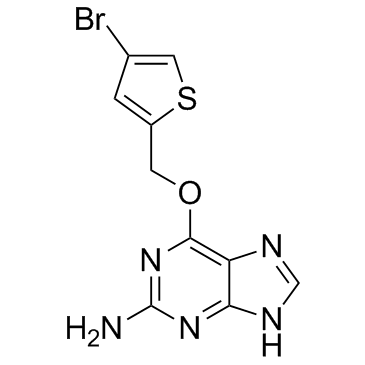Lomeguatrib

Lomeguatrib structure
|
Common Name | Lomeguatrib | ||
|---|---|---|---|---|
| CAS Number | 192441-08-0 | Molecular Weight | 326.172 | |
| Density | 1.9±0.1 g/cm3 | Boiling Point | 683.8±65.0 °C at 760 mmHg | |
| Molecular Formula | C10H8BrN5OS | Melting Point | N/A | |
| MSDS | Chinese USA | Flash Point | 367.3±34.3 °C | |
| Symbol |

GHS07 |
Signal Word | Warning | |
Use of LomeguatribLomeguatrib is a O6-methylguanine-DNA methyltransferase (MGMT) inhibitor, with IC50s of 9 nM in cell-free assay and ∼6 nM in MCF-7 cells. |
| Name | Lomeguatrib |
|---|---|
| Synonym | More Synonyms |
| Description | Lomeguatrib is a O6-methylguanine-DNA methyltransferase (MGMT) inhibitor, with IC50s of 9 nM in cell-free assay and ∼6 nM in MCF-7 cells. |
|---|---|
| Related Catalog | |
| Target |
MGMT:6 nM (IC50, in MCF-7 cells) MGMT:9 nM (IC50) |
| In Vitro | Lomeguatrib (Compound 10) is a O6-methylguanine methyltransferase (MGMT) inhibitor, with an IC50 of 9 nM in cell-free assay[1] and ∼6 nM in MCF-7 cells. Lomeguatrib (10 μM) substantially increases the growth inhibitory effects of temozolomide in MCF-7 cells (D60=10 μM with Lomeguatrib vs 400 μM without)[2]. |
| In Vivo | Lomeguatrib (20 mg/kg i.p.) completely inactivates MGMT within 2 h, but shows no significant effect on tumor growth in MCF-7 xenografts[2]. |
| Kinase Assay | Briefly, 200 μg of extracted cellular protein from HeLaS3 cells in 200 μL of 70 mM HEPES buffer (with 1 mM dithiothreitol (DTT), 5 mM EDTA, pH 7.8) is incubated at 37°C with a defined concentration of Lomeguatrib (added as a DMSO solution). After 30 min an excess of [3H]-methylated DNA (120 000 cpm) is added, and the incubation is continued for an additional 90 min. The reaction is stopped by the addition of 400 μL TCA (13%), and the DNA is hydrolyzed by heating the reaction mixture for 30 min at 98°C. The precipitated protein is washed three times with 400-μL portions of 5% TCA, solubilized in 0.1 N NaOH, and analyzed by liquid scintillation counting using the cocktail Rotiszint eco plus and a TRI-CARB. Enzyme activity is expressed as fmol of [3H]methyl transferred to TCA-insoluble protein material per mg of total cellular protein. Percent inhibition is calculated relative to untreated control samples. Each assay is repeated three times, and IC50 values are determined graphically from plots of percent inhibition vs inhibitor concentration[1]. |
| Cell Assay | To determine toxicity, the MTT growth inhibition assay is employed. Cells (1000 per well) are plated into a 96-well plate and following a 24 h attachment period, Lomeguatrib is added to the cells. After 2 h incubation with Lomeguatrib (10 μM) at 37°C, 5% CO2, increasing doses of temozolomide or vehicle are added and the cells are incubated for a further 4-5 days. At the end of the exposure period, 150 μg MTT is added to each well and plates are incubated for 3 h at 37°C, 5% CO2. The media are removed and the formazan crystals formed in the viable cells are solubilised in 200 μL DMSO. The absorbances at 540 and 690 nm are determined using a ELISA plate reader and growth inhibition calculated as a percentage of the A540-A690 of untreated wells[2]. |
| Animal Admin | Mice[2] To assess the ability of Lomeguatrib to sensitise human breast tumour xenografts to the tumour growth inhibitory effects of temozolomide, groups of at least six nude mice are treated as follows: the vehicle control group are given corn oil then 20% DMSO in PBS; the temozolomide only group are given corn oil then temozolomide (100 mg/kg/day); the Lomeguatrib only group are given Lomeguatrib (20 mg/kg/day) then DMSO in PBS, and the Lomeguatrib plus temozolomide group are given Lomeguatrib (20 mg/kg/day) then temozolomide (100 mg/kg/day). Drugs or vehicles are administered i.p. once daily for 5 days with a separation of 1 h. Up to 10 and at least six animals are assigned to each group, and mean tumour volume is standardised across the groups at the start of the experiment: thus the control, Lomeguatrib, temozolomide and Lomeguatrib plus temozolomide groups had mean tumour volumes of 29.8±7.6 (range 19.0-38.7), 33.2±14.7 (range 16.5-58.7), 35.1±10.9 (range 20.9-52.4) and 30.3±10.0 (range 20.7-44.5) mm3, respectively[2]. |
| References |
| Density | 1.9±0.1 g/cm3 |
|---|---|
| Boiling Point | 683.8±65.0 °C at 760 mmHg |
| Molecular Formula | C10H8BrN5OS |
| Molecular Weight | 326.172 |
| Flash Point | 367.3±34.3 °C |
| Exact Mass | 324.963287 |
| PSA | 117.95000 |
| LogP | 2.36 |
| Appearance of Characters | white to beige |
| Vapour Pressure | 0.0±2.1 mmHg at 25°C |
| Index of Refraction | 1.797 |
| InChIKey | JUJPKFNFCWJBCX-UHFFFAOYSA-N |
| SMILES | Nc1nc(OCc2cc(Br)cs2)c2[nH]cnc2n1 |
| Storage condition | room temp |
| Water Solubility | DMSO: soluble10mg/mL, clear |
| Precursor 3 | |
|---|---|
| DownStream 0 | |
|
Effect of lomeguatrib-temozolomide combination on MGMT promoter methylation and expression in primary glioblastoma tumor cells.
Tumour Biol. 34(3) , 1935-47, (2013) Temozolomide (TMZ) is commonly used in the treatment of glioblastoma (GBM). The MGMT repair enzyme (O (6)-methylguanine-DNA methyltransferase) is an important factor causing chemotherapeutic resistanc... |
|
|
Randomized trial of the combination of lomeguatrib and temozolomide compared with temozolomide alone in chemotherapy naive patients with metastatic cutaneous melanoma.
J. Clin. Oncol. 25(18) , 2540-5, (2007) To evaluate tumor response, pharmacodynamic effects, and safety of a combination of lomeguatrib (LM), an O6-methylguanine DNA-methyltransferase (MGMT) inactivator, and temozolomide (TMZ), TMZ alone, a... |
|
|
[Analysis of the relevant factors of mechanism for telozolomide chemoresistance].
Zhonghua Zhong Liu Za Zhi 33(10) , 794-6, (2011)
|
| Lomeguatrib |
| UNII-S79265T71M |
| 2-Amino-6-[(4-bromo-2-thienyl)methoxy]-9H-purine O6-(4-bromothenyl)guanine |
| 6-[(4-bromothiophen-2-yl)methoxy]-7H-purin-2-amine |
| 6-[(4-Bromo-2-thienyl)methoxy]-7H-purin-2-amine |
| 7H-Purin-2-amine, 6-[(4-bromo-2-thienyl)methoxy]- |
 CAS#:79757-77-0
CAS#:79757-77-0 CAS#:34798-95-3
CAS#:34798-95-3 CAS#:18791-75-8
CAS#:18791-75-8
